The Migratory Locust – A Dreaded Pest of Crops
By Ms. Futhi Magagula
Agricultural production takes place in the midst of pests at all times. Be it livestock or crops or honey production, they all must put up with pests. By definition, pests are plant or animal species that injure agricultural products. Therefore, it includes insect pests and diseases; they are all technically classified as pests. Control of pests must be done to prevent them from building to economic injury levels.
Pests generally have special attributes that allow them to flourish and establish themselves quickly within an environment and exert pressure on agricultural enterprises. It normally takes time before they are noticed, and their presence considered as significant enough to warrant control. Red spider mites and aphids are examples of notorious insect pests of crops – especially those belonging to the Solanaceae family. By the time you see them on the plants, they would have done significant damage already. A similar story can be told about the army worm, which is such a detested pest of maize in Southern Africa today.
There is one pest that holds special characteristics, and it is heavily dreaded by farmers – the Migratory Locust! Between 1929 and 1944, Southern Africa, along with the other countries South of the Equator experienced regular outbreaks of red locusts. The situation repeated itself throughout this period and the international community needed to take action to end this cycle of outbreaks and invasion by the locusts. That is what led to the establishment of the International Red Locust Control Organisation for Central and Southern Africa in 1949.
In the past 10 years, Southern Africa has experienced a rise in the frequency of outbreaks of locusts, along with outbreaks of other transboundary pests. For regions with fragile food security status, such as Southern Africa, this can result in significant food insecurity and starvation.
Locusts are highly destructive pests with a potential to cause 100% crop losses because of their eating habits. A single big swarm of locusts can eat almost 2 million metric tonnes of vegetation in a single day. Thus, thousands of hectares of crops can disappear within a short time when locusts attack a field. Its control is also complicated if the nymphs become gregarious and develop from the hopping stage to flight stage when they form swarms.
Controlling a swarm of locusts is like chasing a moving target, something that is extremely difficult. Individual farmers can’t undertake control measures of swarms or large number of nymphs. Therefore, the cooperation of countries at regional and global levels is extremely important. At that level, countries can easily conduct surveillance in the already known breeding grounds and control the nymphs while still in the hoper stage. Where there is a challenge in accessing the breeding grounds on foot, some countries use aeroplanes.
Climate change has been linked to the recent outbreaks of locusts in the region. The extreme weather events such as drought, high temperatures, high and intense rainfall in some areas create conditions that support the breeding and outbreak of some pests. This further justifies the need for more effective regional and international collaboration. CCARDESA is already seeking ways of developing a project that could contribute to the surveillance and control of the migratory locusts in Southern Africa.
With the recent developments in technology, locust surveillance and control can be done more precisely to avoid any outbreaks. There is recent evidence showing that by using a combination of data on vegetation index, soil moisture and other observations, the outbreak of locusts can be predicted very well and gain enough time for early warning and preparation for control. Such developments can replace the traditional approach of ground surveillance. Similarly, new technologies are being employed to control locusts. In 2020, China was reported to be using drones to control swarms of locusts.
A combination of international cooperation, improved surveillance and control measures using new approaches and technologies would be adequate control and management of this pest. This pest is too big an obstacle for farmers to deal with. The anguish the farmers go through when the sky gets dark in the middle of the day due to locusts, and the thought of the resulting devastation are depressing.
This article first appeared on ccardesa.org
The author is the CAADP-XP4 Programme Officer



